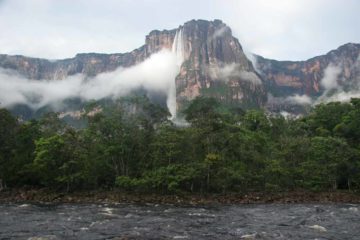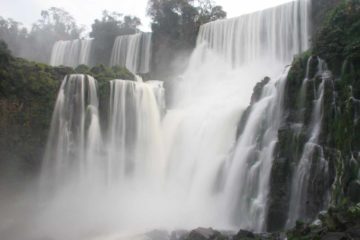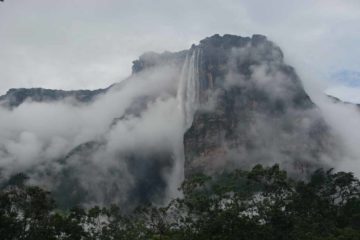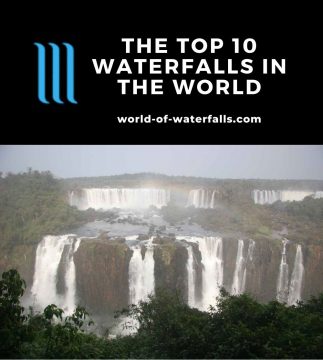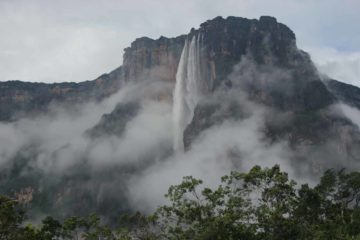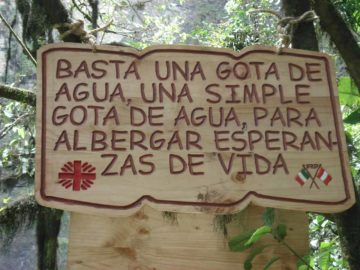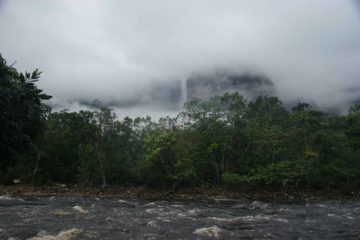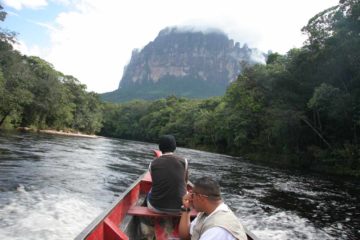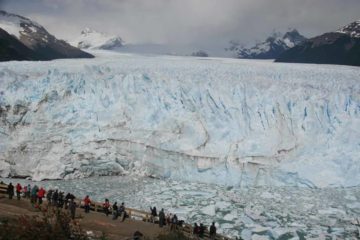About Angel Falls
Angel Falls, the tallest waterfall in the world, drops nearly a kilometer (about 979m total drop with 807m freefall) from a table-top mountain (tepuy or tepui in the indigenous Pemón language).
Of all the famous waterfalls that Julie and I have been to, this one seemed to invoke a sense of mystery and adventure. This was probably due to the fact that its remote location meant we needed to endure long transits plus a pretty strenuous and muggy hike to the overlook pictured at the top of this page. On top of that, the elusive falls was frequently shrouded in clouds. Only Mother Nature revealed this gem on her terms and we were relegated to hope she would be kind to us on the limited amount of time we were there. Plus, we had heard about legends regarding its discovery by the Western world, and we were intrigued by the lost world atop the falls where I’m certain not many people have been.
The tepuy from which Angel Falls makes its dramatic plunge is known as Auyantepuy (or Auyantepui) meaning “Mountain of the God of Evil” as well as “Devil’s Mountain”. The waterfall’s existence seemed to us like a paradox as it didn’t appear to be fed by conventional drainage sources such as snow or glacier melt, lakes, nor a major river system. Instead, the abundance of water responsible for the falls was practically all rainfall from equatorial tropical clouds condensing onto the cloud forest atop the tepuy’s plateau. It was almost as if the clouds wrung its water onto the tepuy like a soaked rag.
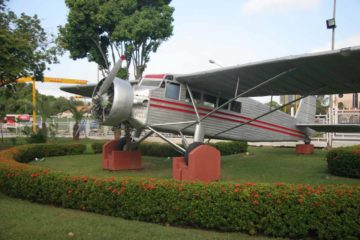
According to the literature that we’ve been exposed to, given the soggy terrain atop the tepuy, Angel, his wife, and two friends landed the plane but couldn’t take off again. They had no choice but to make the difficult trek down from the vertical cliffs of the tepui towards civilization (taking around 11 days). Only after successfully performing that feat did the falls become known to the rest of the world, and so eventually the falls were named after Jimmy Angel himself. His plane has since been moved, restored, and we saw it (or at least a replica of it) on display at the airport in Ciudad Bolívar.
To give you an idea of what it took for us to see the falls, we first had to endure sore bums riding a small motorized boat against the current of two different rivers (i.e. El Rio Carrao and the almost blood-colored Rio Churun) for four hours. Once the boat ride was done, we then had to cross a stream (the same one responsible for the falls) before embarking on a steep and uphill 90-minute hike. I recalled we brought Keens to handle both the water and the hiking, but if we were to bring hiking boots, then we probably would’ve carried an extra pair of water shoes or sandals so as to not ruin the boots on that stream crossing.
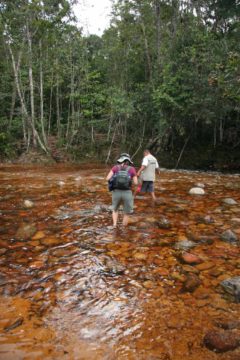
Anyways, once we were at the overlook (mirador), there was limited space so at first there was a crowd, but it did eventually lighten up as we lingered there waiting for the clouds to part and reveal the falls itself. Our arrival was pretty late in the day so we didn’t continue hiking towards the pool by the base of the cascades below the base of the main falls. When the day was done, we slept on hammocks with mosquito nets in an open-air camp covered with a corrugated tin roof.
Given the adventure it took to get here, you could argue that this type of excursion was more about the journey than the destination. Yet it was probably because of the uncertainties surrounding our excursion that the reward and exhilaration factor was amplified when the falls was revealed to us.
In the short time we were able to witness Angel Falls, we saw it take on many forms – from thick multi-segmented horsetail plumes to a thinner horsetail that disappeared into mist on its way down before reappearing as lower cascades for the remainder of its drop. We tried to time our trip to ensure the highest likelihood of seeing the falls flow while trading that with the likelihood of clouds obscuring our view of the falls (as well as trying to take advantage of holidays). To read about our thought process and how we made our decision, click here.
We were even fortunate to have good enough weather to fly by the falls on the way back to Ciudad Bolivar from Canaima. That allowed us to experience the grandeur of the falls from an aerial perspective.
Adding to the allure of this mystical waterfall was the fact that we got to experience other waterfalls as part of this excursion. These waterfalls included Salto Ucaima, Salto Golondrina, Salto Wadaima, Salto Hacha, and Sapo Falls as well as a few other lesser known or unnamed ones.
I could probably keep going on about our experience here, but I’ll let the pictures and videos do the rest of the talking. So check out the rest of this page below to learn more about the graceful Angel Falls…
Related Top 10 Lists
Trip Planning Resources
Nearby Accommodations
This content is for members only. See Membership Options.Featured Images and Nearby Attractions
This content is for members only. See Membership Options.Visitor Comments:
Got something you'd like to share or say to keep the conversation going? Feel free to leave a comment below... Gene and Jody Primoff in Canaima, 1978 January 11, 2015 7:25 pm - In 1978 we visited Canaima and stayed near the lagoon. On the way there,our airplane routed us past Angel Falls and we got a good look at the incredible sight. Soon after,we landed near the camp site. We ate our good meals outside under some trees. We spent a lot of time walking on trails… ...Read More
Gene and Jody Primoff in Canaima, 1978 January 11, 2015 7:25 pm - In 1978 we visited Canaima and stayed near the lagoon. On the way there,our airplane routed us past Angel Falls and we got a good look at the incredible sight. Soon after,we landed near the camp site. We ate our good meals outside under some trees. We spent a lot of time walking on trails… ...Read More Hiked there in 2004 – December June 12, 2013 3:23 am - 4.5 hr flight from LAX to ATL; ATL to Caracas, Was going to get taxi from airport (about 45 minutes outside Caracas proper) to hotel but friendly seatmate from the airplane gave me a ride to my hotel. Overnight in Caracas (Hilton, had pre booked prior to arrival). Met 4 other traveling companions next day,… ...Read More
Hiked there in 2004 – December June 12, 2013 3:23 am - 4.5 hr flight from LAX to ATL; ATL to Caracas, Was going to get taxi from airport (about 45 minutes outside Caracas proper) to hotel but friendly seatmate from the airplane gave me a ride to my hotel. Overnight in Caracas (Hilton, had pre booked prior to arrival). Met 4 other traveling companions next day,… ...Read More I’ve seen Angel Falls from the base and the top. Breathtaking! November 1, 2012 10:50 pm - My husband was a bush pilot in Venezuela during the 1950s.Our planes were based in Ciudad Bolivar. We often saw Angel Falls from the cockpit of one of our single-engine Cessnas. The most exhilarating flights, however, were those we made in a helicopter in 2004 and 2007. Our pilot hovered so close to the falls,… ...Read More
I’ve seen Angel Falls from the base and the top. Breathtaking! November 1, 2012 10:50 pm - My husband was a bush pilot in Venezuela during the 1950s.Our planes were based in Ciudad Bolivar. We often saw Angel Falls from the cockpit of one of our single-engine Cessnas. The most exhilarating flights, however, were those we made in a helicopter in 2004 and 2007. Our pilot hovered so close to the falls,… ...Read More Angel Falls as amazing as imagined January 12, 2012 4:11 pm - My husband and I visited Angel Falls years ago and I will never forget that trip. We flew in commercial on a 737. It was in early summer and CLEAR and the falls were full, which is rare, so he flew us by the falls at 1200 ft and at slow speed, then turned around… ...Read More
Angel Falls as amazing as imagined January 12, 2012 4:11 pm - My husband and I visited Angel Falls years ago and I will never forget that trip. We flew in commercial on a 737. It was in early summer and CLEAR and the falls were full, which is rare, so he flew us by the falls at 1200 ft and at slow speed, then turned around… ...Read More Visiting Venezuela 2008 October 21, 2011 1:35 pm - I spent a short holiday on February 2008 in Isla de Margarita. Travel agency had some day trips to offer and I chose excursion to Canaima. First we stopped in Puerto Ordaz where Orinoco and Caroni meet. And followed to Canaima not seeing Angel Falls. They told us that because of the weather we'll be… ...Read More
Visiting Venezuela 2008 October 21, 2011 1:35 pm - I spent a short holiday on February 2008 in Isla de Margarita. Travel agency had some day trips to offer and I chose excursion to Canaima. First we stopped in Puerto Ordaz where Orinoco and Caroni meet. And followed to Canaima not seeing Angel Falls. They told us that because of the weather we'll be… ...Read More Wonderful experience June 3, 2011 11:55 pm - I went to see Angel Falls as a sole traveler and it was a marvelous experience. While I did not like Venezuela much, the waterfalls were astonishing. Their view ... breathtaking and the sound they made was incredible. I choose to go with a small plane, but seeing the jungle from above, I wish I… ...Read More
Wonderful experience June 3, 2011 11:55 pm - I went to see Angel Falls as a sole traveler and it was a marvelous experience. While I did not like Venezuela much, the waterfalls were astonishing. Their view ... breathtaking and the sound they made was incredible. I choose to go with a small plane, but seeing the jungle from above, I wish I… ...Read More Amazing waterfall November 1, 2010 5:52 am - Angel Falls is one of the most extreme places which is worth to seeing. Having been there with my friends, we were mesmerized with its beauty! It was like dreaming. My friends & I were so much involved in the beauty that we didn't speak for hours. It was an unforgettable and breathtaking experience. ...Read More
Amazing waterfall November 1, 2010 5:52 am - Angel Falls is one of the most extreme places which is worth to seeing. Having been there with my friends, we were mesmerized with its beauty! It was like dreaming. My friends & I were so much involved in the beauty that we didn't speak for hours. It was an unforgettable and breathtaking experience. ...Read More Angel Falls June 2, 2010 2:02 am - I was there in July 2009 - definitely one of the highlights of my life. If I may say something controversial, I have been at the Tugela Falls in South Africa a couple of times, and I think they might be higher than Angel Falls ... ...Read More
Angel Falls June 2, 2010 2:02 am - I was there in July 2009 - definitely one of the highlights of my life. If I may say something controversial, I have been at the Tugela Falls in South Africa a couple of times, and I think they might be higher than Angel Falls ... ...Read More Over, Around, and Beside Angel Falls January 30, 2010 12:36 am - My husband and I visited my parents in Venezuela in 1965. Dad was on loan to a Venezuelan steel company and as he and my step-mother lived in Caracas and the plant was in Puerto Ordaz, they had access to a small plane. I don't remember the make (think it was a Cessna) but there… ...Read More
Over, Around, and Beside Angel Falls January 30, 2010 12:36 am - My husband and I visited my parents in Venezuela in 1965. Dad was on loan to a Venezuelan steel company and as he and my step-mother lived in Caracas and the plant was in Puerto Ordaz, they had access to a small plane. I don't remember the make (think it was a Cessna) but there… ...Read More Frequent Guest (Angel Falls) April 28, 2009 10:08 pm - Although I have never been to Angel Falls I do have a connection to them. My father and our family lived in British Guiana during the 40's and 50's. My dad was a government negotiator for part of that time and we lived on Atkinson Field, a former American air base. It was during that… ...Read More
Frequent Guest (Angel Falls) April 28, 2009 10:08 pm - Although I have never been to Angel Falls I do have a connection to them. My father and our family lived in British Guiana during the 40's and 50's. My dad was a government negotiator for part of that time and we lived on Atkinson Field, a former American air base. It was during that… ...Read More Memorable Angel Falls April 28, 2009 2:09 pm - Back in 1994 I took a flight out of Barcelona (Puerto La Cruz) Venezuela to Canaima. It was a 3 or 4 hour flight (one way) in an old DC3 aircraft. After landing at Canaima we were taken on a 3 hour long trip through the surrounding area ending up having lunch near the falls… ...Read More
Memorable Angel Falls April 28, 2009 2:09 pm - Back in 1994 I took a flight out of Barcelona (Puerto La Cruz) Venezuela to Canaima. It was a 3 or 4 hour flight (one way) in an old DC3 aircraft. After landing at Canaima we were taken on a 3 hour long trip through the surrounding area ending up having lunch near the falls… ...Read More Jungle Rudy’s August 3, 2008 6:33 pm - I am 88 yrs old now, but when I was 50 (about?) my husband flew us in our Bonanza to Jungle Rudy's where we landed in the fields and stayed with him for a few days. He showed us his maps so we could try to fly into the canyon by Angel Falls. It was… ...Read More
Jungle Rudy’s August 3, 2008 6:33 pm - I am 88 yrs old now, but when I was 50 (about?) my husband flew us in our Bonanza to Jungle Rudy's where we landed in the fields and stayed with him for a few days. He showed us his maps so we could try to fly into the canyon by Angel Falls. It was… ...Read MoreVisitor Reviews of this Waterfall:
If you have a waterfall story or write-up that you'd like to share, feel free to click the button below and fill out the form...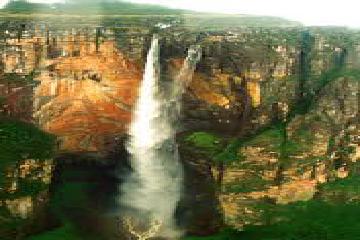 angeles falls July 12, 2014 4:21 am - last year i visit it with my friends in a tour as us west coast tours. it is very beautiful to see. we enjoy there a lot and take some pictures also. It is more than 19 times higher than Niagara Falls. ...Read More
angeles falls July 12, 2014 4:21 am - last year i visit it with my friends in a tour as us west coast tours. it is very beautiful to see. we enjoy there a lot and take some pictures also. It is more than 19 times higher than Niagara Falls. ...Read More
